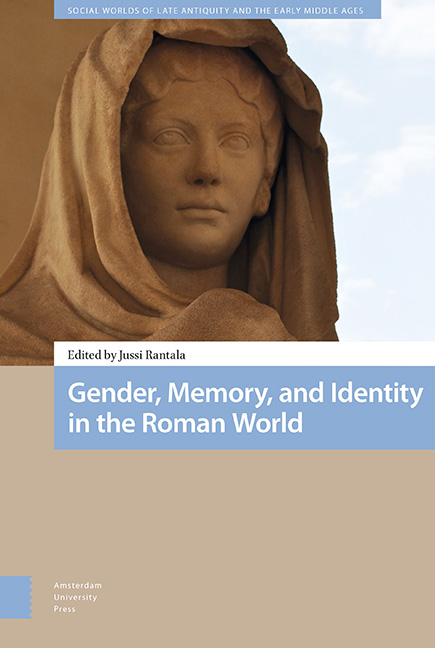Book contents
- Frontmatter
- Contents
- List of Illustrations
- Abbreviations
- Preface
- Tabula Gratulatoria
- Introduction
- 1 Public Agency of Women in the Later Roman World
- 2 Religious Agency and Civic Identity of Women in Ancient Ostia
- 3 The Invisible Women of Roman Agrarian Work and Economy
- 4 ‘Show them that You are Marcus’s Daughter’
- 5 Defining Manliness, Constructing Identities
- 6 ‘At the Age of Nineteen’ (RG 1)
- 7 Conflict and Community
- 8 Dress, Identity, Cultural Memory
- 9 The Goddess and the Town
- 10 Varius, multiplex, multiformis – Greek, Roman, Panhellenic
- 11 Mental Hospitals in Pre-Modern Society
- Index
5 - Defining Manliness, Constructing Identities
Published online by Cambridge University Press: 20 November 2020
- Frontmatter
- Contents
- List of Illustrations
- Abbreviations
- Preface
- Tabula Gratulatoria
- Introduction
- 1 Public Agency of Women in the Later Roman World
- 2 Religious Agency and Civic Identity of Women in Ancient Ostia
- 3 The Invisible Women of Roman Agrarian Work and Economy
- 4 ‘Show them that You are Marcus’s Daughter’
- 5 Defining Manliness, Constructing Identities
- 6 ‘At the Age of Nineteen’ (RG 1)
- 7 Conflict and Community
- 8 Dress, Identity, Cultural Memory
- 9 The Goddess and the Town
- 10 Varius, multiplex, multiformis – Greek, Roman, Panhellenic
- 11 Mental Hospitals in Pre-Modern Society
- Index
Summary
Abstract
This study looks at the conceptions of gender and public identities and how these conceptions are constructed by the reuse of the image of Alexander the Great (356-323 BCE) as an exemplary man in Late Antiquity. My sources contain texts representing various literary genres composed especially during the fourth and fifth centuries CE. I first analyse constructions of manliness through the image of Alexander, from the perspective of martial virtue. Next, I explore how the patriarchal order and gender roles are defined by anecdotes about Alexander and about his dealings with women as well as with his mother, Olympias. Finally, I deal with the image of Alexander as an exemplary man in the construction of ethnic and socio-cultural identities. This article shows that for authors of Late Antiquity, writing about the past was about defining themselves in terms of gender, ethnic, and cultural identity.
Keywords: Alexander the Great, Late Antiquity, masculinity, identity
Introduction
This study looks at the literary tradition surrounding Alexander III (356-323 BCE), best known as Alexander the Great, in Late Antiquity. I examine conceptions of gender and public identities and how these conceptions are constructed by the reuse of the image of Alexander as an exemplary man in Late Antiquity. My sources contain texts representing various literary genres composed especially during the fourth and fifth centuries CE. In this volume of collected papers, this study sheds light on the continuity and change of constructions of manliness and public identities within the Roman Empire.
Only a few historical figures – if any – have provoked as much interest and fascination as Alexander has. Richard Stoneman aptly writes that ‘Alexander's name has continued to resound through the centuries’. Alexander's figure as an exemplary man had an important legacy in both the Hellenistic world and in the Early Roman Empire where Latin Romans and Greek Romans wrote about his reign and personality. The cultural phenomenon of imitatio Alexandri was a common tool in Roman literature. Notable Roman statesmen and emperors identified themselves with Alexander.
- Type
- Chapter
- Information
- Gender, Memory, and Identity in the Roman World , pp. 131 - 156Publisher: Amsterdam University PressPrint publication year: 2019

